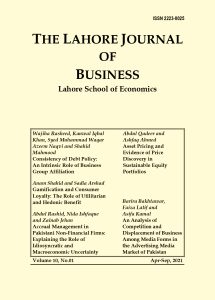Brand Equity Creation through a Moderated Mediation Model in the Luxury Brand Industry
- Mehrukh Salman
- mehrukh.jawaid@gmail.com (Primary Contact)
- Assistant Professor Lahore School of Economics (Corresponding Author)
Submitted
November 22, 2023
Accepted
November 22, 2023
Accepted
November 22, 2023
Abstract
This research gauges the role of brand experience and perceived social media marketing activities in the creation of consumer-based brand equity using a stimulus organism-response model. The data was collected through a structured questionnaire focused on luxury fashion brands. The sample, consisting of 243 usable responses, was analyzed using structural equation modelling in Smart PLS4. Our results show that perceived social media activities play a vital role in the creation of brand equity. Brand experience partially mediates the association between consumer-based brand equity and perceived social media marketing. Interestingly, high brand trust contributes to higher consumer-based brand equity. This study is adds value to the literature by focusing on the role of perceived social media marketing activities in the creation of consumer based brand equity through a second-stage approach to moderated mediation using brand experience and brand trust. The study also has valuable managerial implications that could help businesses enhance their consumer-based brand equity. Luxury fashion brands should maximize customer experience through social media activities and engagement. Fashion brands should also invest in personalized recommendation engines on social media platforms to improve consumer experience
Keywords
Perceived social media activities
brand experience
brand trust
consumer-based brand equity
moderated mediation
This work is licensed under LJB.
- Citation
Salman, M., & Chaudary, S. (2023). Brand Equity Creation through a Moderated
Mediation Model in the Luxury Brand Industry. The Lahore Journal of Business, 11(1), 81-102
- References
2: Agarwal, B., & Gulla A. (2022). Influence of social media marketing on customer equity drivers and purchase intention: Understanding world’s most valuable brand—Amazon. Management Review, 30(3), 99–113.
3: Agarwal, R., & Karahanna, E. (2000). Time flies when you’re having fun: Cognitive absorption and beliefs about information technology usage. MIS Quarterly, 24(4), 665–694.
4: Alsaad, A., Mohamad, R., & Ismail, N. A. (2017). The moderating role of trust in business-to-business electronic commerce (B2B EC) adoption. Computers in Human Behavior, 68, 157–169.
5: Altaf, M., Iqbal, N., Mokhtar, S. S., & Sial, M. H. (2017). Managing consumer-based brand equity through brand experience in Islamic banking. Journal of Islamic Marketing, 8(2), 218–242
6: Ananda, A., Hernandez-Garcia, A., Acquila-Natale, E., & Lamberti, L. (2019). What makes fashion consumers ‘click’? Generation of eWoM engagement in social media. Asia Pacific Journal of Marketing and Logistics, 31(2), 398–418.
7: Animesh, A., Pinsonneault, A., Yang, S. B., & Oh, W. (2011). An odyssey into virtual worlds: Exploring the impacts of technological and spatial environments on intention to purchase virtual products. MIS Quarterly, 35(3), 789–810.
8: Appiah, D., Ozuem, W., Howell, K. E., & Lancaster, G. (2019). Brand switching and consumer identification with brands in the smartphones industry. Journal of Consumer Behavior, 18(6), 463–473.
9: Ausat, A. M. A. (2023). The role of social media in shaping public opinion and its influence on economic decisions. Technology and Society Perspectives, 1(1), 35–44.
10: Baldus, B. J., Voorhees, C., & Calantone, R. (2015). Online brand community engagement: Scale development and validation. Journal of Business Research, 68(5), 978–985.
11: Bazi, S., Filieri, R., & Gorton, M. (2023). Social media content aesthetic quality and customer engagement: The mediating role of entertainment and impacts on brand love and loyalty. Journal of Business Research, 160, 113778.
12: Beck, S., & Prügl, R. (2018). Family firm reputation and humanization: Consumers and the trust advantage of family firms under different conditions of brand familiarity. Family Business Review, 31(4), 460–482.
13: Beig, F. A., & Khan, M. F. (2018). Impact of social media marketing on brand experience: A study of select apparel brands on Facebook. Vision, 22(3), 264-275.
14: Bell, E., Bryman, A., & Harley, B. (2018). Business research methods. Oxford University Press.
15: Brakus, J. J. J., Schmitt, B. H., & Zarantonello, L. (2009). Brand experience: What is it? How is it measured? Does it affect loyalty? Journal of Marketing, 73(3), 52–68.
16: Bruhn, M., Schoenmueller, V., & Schäfer, D. B. (2012). Are social media replacing traditional media in terms of brand equity creation? Management Research Review, 35(9), 770–790.
17: Cassel, C., Hackl, P., & Westlund, A. H. (1999). Robustness of partial least-squares method for estimating latent variable quality structures. Journal of Applied Statistics, 26(4), 435–446.
18: Chen, S. C., & Lin, C. P. (2019). Understanding the effect of social media marketing activities: The mediation of social identification, perceived value and satisfaction. Technological Forecasting and Social Change, 140, 22–32.
19: Chen, X., & Qasim, H. (2020). Does e‐brand experience matter in the consumer market? Explaining the impact of social media marketing activities on consumer‐based brand equity and love. Journal of Consumer Behavior, 20(5), 1065–1077.
20: Chin, W. W., Thatcher, J. B., Wright, R. T., & Steel, D. (2013). Controlling for common method variance in PLS analysis: the measured latent marker variable approach. In Chin, W.W., Russolillo, V.E.
Read More
